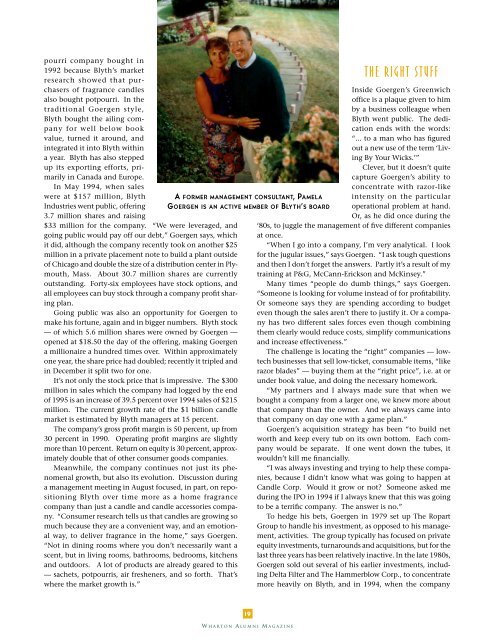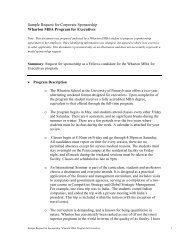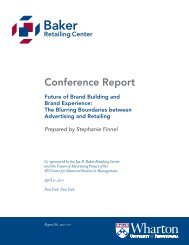wharton's prescription for health care - Wharton Magazine
wharton's prescription for health care - Wharton Magazine
wharton's prescription for health care - Wharton Magazine
Create successful ePaper yourself
Turn your PDF publications into a flip-book with our unique Google optimized e-Paper software.
pourri company bought in1992 because Blyth’s marketresearch showed that purchasersof fragrance candlesalso bought potpourri. In thetraditional Goergen style,Blyth bought the ailing company<strong>for</strong> well below bookvalue, turned it around, andintegrated it into Blyth withina year. Blyth has also steppedup its exporting ef<strong>for</strong>ts, primarilyin Canada and Europe.In May 1994, when saleswere at $157 million, BlythIndustries went public, offering3.7 million shares and raisingA FORMER MANAGEMENT CONSULTANT, PAMELAGOERGEN IS AN ACTIVE MEMBER OF BLY TH’SBOARDTHE RIGHT STUFFInside Goergen’s Greenwichoffice is a plaque given to himby a business colleague whenBlyth went public. The dedicationends with the words:“... to a man who has figuredout a new use of the term ‘LivingBy Your Wicks.’”Clever, but it doesn’t quitecapture Goergen’s ability toconcentrate with razor-likeintensity on the particularoperational problem at hand.Or, as he did once during the$33 million <strong>for</strong> the company. “We were leveraged, andgoing public would pay off our debt,” Goergen says, whichit did, although the company recently took on another $25million in a private placement note to build a plant outsideof Chicago and double the size of a distribution center in Plymouth,Mass. About 30.7 million shares are currentlyoutstanding. Forty-six employees have stock options, andall employees can buy stock through a company profit sharingplan.Going public was also an opportunity <strong>for</strong> Goergen tomake his <strong>for</strong>tune, again and in bigger numbers. Blyth stock— of which 5.6 million shares were owned by Goergen —opened at $18.50 the day of the offering, making Goergena millionaire a hundred times over. Within approximatelyone year, the share price had doubled; recently it tripled andin December it split two <strong>for</strong> one.It’s not only the stock price that is impressive. The $300million in sales which the company had logged by the endof 1995 is an increase of 39.5 percent over 1994 sales of $215million. The current growth rate of the $1 billion candlemarket is estimated by Blyth managers at 15 percent.The company’s gross profit margin is 50 percent, up from30 percent in 1990. Operating profit margins are slightlymore than 10 percent. Return on equity is 30 percent, approximatelydouble that of other consumer goods companies.Meanwhile, the company continues not just its phenomenalgrowth, but also its evolution. Discussion duringa management meeting in August focused, in part, on repositioningBlyth over time more as a home fragrancecompany than just a candle and candle accessories company.“Consumer research tells us that candles are growing somuch because they are a convenient way, and an emotionalway, to deliver fragrance in the home,” says Goergen.“Not in dining rooms where you don’t necessarily want ascent, but in living rooms, bathrooms, bedrooms, kitchensand outdoors. A lot of products are already geared to this— sachets, potpourris, air fresheners, and so <strong>for</strong>th. That’swhere the market growth is.”‘80s, to juggle the management of five different companiesat once.“When I go into a company, I’m very analytical. I look<strong>for</strong> the jugular issues,” says Goergen. “I ask tough questionsand then I don’t <strong>for</strong>get the answers. Partly it’s a result of mytraining at P&G, McCann-Erickson and McKinsey.”Many times “people do dumb things,” says Goergen.“Someone is looking <strong>for</strong> volume instead of <strong>for</strong> profitability.Or someone says they are spending according to budgeteven though the sales aren’t there to justify it. Or a companyhas two different sales <strong>for</strong>ces even though combiningthem clearly would reduce costs, simplify communicationsand increase effectiveness.”The challenge is locating the “right” companies — lowtechbusinesses that sell low-ticket, consumable items, “likerazor blades” — buying them at the “right price”, i.e. at orunder book value, and doing the necessary homework.“My partners and I always made sure that when webought a company from a larger one, we knew more aboutthat company than the owner. And we always came intothat company on day one with a game plan.”Goergen’s acquisition strategy has been “to build networth and keep every tub on its own bottom. Each companywould be separate. If one went down the tubes, itwouldn’t kill me financially.“I was always investing and trying to help these companies,because I didn’t know what was going to happen atCandle Corp. Would it grow or not? Someone asked meduring the IPO in 1994 if I always knew that this was goingto be a terrific company. The answer is no.”To hedge his bets, Goergen in 1979 set up The RopartGroup to handle his investment, as opposed to his management,activities. The group typically has focused on privateequity investments, turnarounds and acquisitions, but <strong>for</strong> thelast three years has been relatively inactive. In the late 1980s,Goergen sold out several of his earlier investments, includingDelta Filter and The Hammerblow Corp., to concentratemore heavily on Blyth, and in 1994, when the company19W HARTON ALUMNI MAGAZINE
















